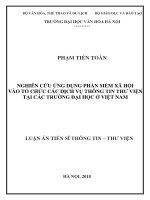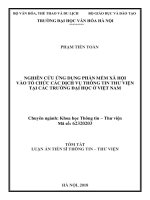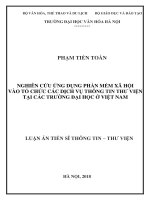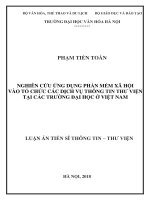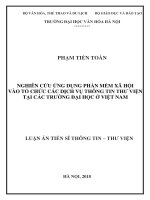Nghiên cứu nhận thức của sinh viên tại một trường đại học ở việt nam về năng lực giao tiếp liên văn hóa
Bạn đang xem bản rút gọn của tài liệu. Xem và tải ngay bản đầy đủ của tài liệu tại đây (267.74 KB, 72 trang )
VIETNAM NATIONAL UNIVERSITY, HANOI
UNIVERSITY OF LANGUAGES AND INTERNATIONAL STUDIES
FACULTY OF POSTGRADUATE STUDIES
*********************
NGUYỄN THU TRANG
AN INVESTIGATION INTO STUDENTS’ PERCEPTION
OF INTERCULTURAL COMMUNICATION
COMPETENCE
AT A VIETNAMESE
UNIVERSITY
(Nghiên cứu nhận thức của sinh viên tại một trường đại học ở Việt
Nam
về năng lực giao tiếp liên văn hóa)
M.A MINOR THESIS (Type 1)
Field: English Teaching Methodology
Code: 8140231.01
Hanoi - 2019
VIETNAM NATIONAL UNIVERSITY, HANOI
UNIVERSITY OF LANGUAGES AND INTERNATIONAL STUDIES
FACULTY OF POSTGRADUATE STUDIES
*********************
NGUYỄN THU TRANG
AN INVESTIGATION INTO STUDENTS’ PERCEPTION
OF INTERCULTURAL COMMUNICATION COMPETENCE
AT A VIETNAMESE UNIVERSITY
(Nghiên cứu nhận thức của sinh viên tại một trường đại học ở Việt
Nam về năng lực giao tiếp liên văn hóa)
M.A MINOR THESIS (Type 1)
Field: English Teaching Methodology
Code: 8140231.01
Supervisor: Prof. Nguyễn Hòa
Hanoi - 2019
DECLARATION
I declare that this research paper entitled “An investigation into students’ perception
of intercultural communication competence at a Vietnamese university” was
composed of myself except as cited in the references. The thesis has not been
currently submitted in candidature of any other degree or processional qualification
except as specified.
Signature
Nguyễn Thu Trang
Hanoi, June 26th 2019
1
ACKNOWLEDGEMENTS
I would like to dedicate my warm thanks to my supervisor, Prof. Nguyễn Hòa, for
his academic, specialized and creative guidance. He has been my source of
comprehensive knowledge and great inspiration throughout my postgraduate
studies.
I would also like to show my gratitude to all the students for their participation in
the survey who supported my work and helped me get results of reliable and better
quality.
I am also indebted to my friend, Linh, who was always there for me during my hard
time of carrying out this thesis. Thank you for continuously encouraging me to
overcome obstacles to fully complete this study.
Last but not least, I would like to express my special thanks and love to my family,
my parents for supporting me spiritually throughout my writing of this research
paper.
2
ABSTRACT
This study investigated the students’ awareness of intercultural communication
competence at a Vietnamese university. I used mixed method (quantitative and
qualitative method), which includes a survey questionnaire and semi-structured
interviews to identify students’ perception toward ICC. The results of the study
suggested that the majority of students of the research do not have enough
awareness of the importance of intercultural communication competence.
Keywords: intercultural communication competence, perception, Vietnamese
university…
3
Table of Contents
DECLARATION........................................................................................................i
ACKNOWLEDGEMENTS......................................................................................ii
ABSTRACT.............................................................................................................iii
LIST OF ABBREVIATIONS...................................................................................vi
LIST OF TABLES....................................................................................................vi
CHAPTER 1: INTRODUCTION..............................................................................1
1.1
Rationale......................................................................................................1
1.2.
Objectives of the research and Research question........................................2
1.3.
Research methodology.................................................................................3
1.4.
Significance of the research.........................................................................3
1.5.
Thesis structure............................................................................................4
CHAPTER 2: LITERATURE REVIEW...................................................................5
2.1.
Definition of perception...............................................................................5
2.2.
Definition of culture.....................................................................................6
2.3. Definition of Communication competence, Intercultural competence,
Intercultural communication competence..............................................................8
2.3.1.
Definition of Communication competence............................................8
2.3.2.
Definition of Intercultural competence..................................................9
2.3.3.
Definition of Intercultural communication competence......................10
2.4.
Model of Intercultural communication competence...................................12
2.5.
Previous studies..........................................................................................13
2.6.
Chapter summary.......................................................................................18
CHAPTER 3: METHODOLOGY...........................................................................19
3.1. Context of the study......................................................................................19
3.2. Design of the study........................................................................................20
3.3.
Participants.................................................................................................21
3.4.
Data collection...........................................................................................21
4
3.4.1.
Questionnaires.....................................................................................21
3.4.2.
Semi-structured interviews..................................................................23
3.5.
Data analysis..............................................................................................25
CHAPTER 4: FINDINGS AND DISCUSSION......................................................26
4.1. Results...........................................................................................................26
4.1.1. The result of questionnaire......................................................................26
4.1.2.
4.2.
The result of interview.........................................................................34
Discussion..................................................................................................38
CHAPTER 5: CONCLUSION................................................................................42
5.1.
Recapitulation............................................................................................42
5.2.
Implications................................................................................................43
5.3.
Limitations.................................................................................................45
5.4.
Suggestion for further research..................................................................45
REFERENCES........................................................................................................47
APPENDICES...........................................................................................................I
APPENDIX 1.........................................................................................................I
APPENDIX 2........................................................................................................V
APPENDIX 3.......................................................................................................VI
5
LIST OF ABBREVIATIONS
CC
IC
ICC
Communication competence
Intercultural communication
Intercultural communication competence
LIST OF TABLES
Table 1a
Criteria of assessing students’ intercultural awareness (for
Table 1b
positive statement)
Criteria of assessing students’ intercultural awareness (for
Table 2
Table 3
Table 4
negative statement)
Measure students’ intercultural awareness
Measure students’ ICC (Using positive statements)
Measure students’ ICC (Using negative statements)
6
CHAPTER 1: INTRODUCTION
This chapter presents the rationale, objectives, research question, research
methodology, scope, thesis significance and thesis structure.
1.1 Rationale
Within the context of globalization, intercultural communicative competence (ICC)
has been identified as one of the foremost competencies for foreign language
learners to tackle appropriately and effectively in multicultural situations. Despite
that fact, there is a limited number of instructional models that include the
intercultural content in English language teaching and learning so as to educate
foreign language learners to become successful intercultural speakers. As a
consequence,
the intercultural language
approach aims
to
present
foreign
language learners with cultural differences which help them to appreciate and
respect the variance of culture. In addition, learners should be equipped with the
knowledge of intercultural communication and the ability to use it effectively in
order to bridge cultural differences and achieve more harmonious, productive
relations (Samovar, Porter, & McDaniel, 2012).
Undoubtedly, the role of culture and intercultural communication in English
language education has not always been well-acknowledged. Gonen and Saglam
(2012) pointed out that: “teachers in different classrooms in different parts of the
world still ignore the importance of teaching culture as a part of language study” (p.
26). Teachers focus only on promoting learners’ language proficiency rather than
integrate it with intercultural communication in order to perform effectively and
appropriately in multicultural situations. In the context of Vietnam, intercultural
language teaching is not also a current practice in English language education
since the integration of culture in teaching and learning is usually ignored. Such
situations can trigger the phenomenon that foreign language learners may have the
1
tools for fluency, but they may not be effective and appropriate interactants in
multicultural situations.
For all the time I studied at the university, I was attracted by the cultural differences.
The attention I have for it got stronger when I was exposed to intercultural
communication. I believed that culture and language must be together, for whatever
the level of language learner is. However, it seemed that not many students share
my thought. They might be all agree about the importance of intercultural
communication competence, but they do not really take that fact seriously.
Therefore, I would like to carry out a research to see the current situation of
students and then, raise the awareness for us, especially for the foreign language
educator of the necessity and momentousness of intercultural communication
competence.
1.2.
Objectives of the research and Research question
I aimed at figuring out students’ understanding of intercultural communication
competence. The research clarified the actual situation of Vietnamese university
students’ awareness of what belongs to inter-culture. After that, I took a closer look
at the background of language learning situation of Vietnam and then, pointed out
the importance of raising awareness of intercultural communication in both learning
and teaching process. They are used to look for the answer to the question: What is
students’ perception of intercultural communication competence at a Vietnamese
university?
2
1.3.
Research methodology
I used the mixed method which includes quantitative and qualitative method for
data collection and analysis. The research consists of questionnaire and semistructured interview.
Twenty students from one class that already passed a course named “Intercultural
communication” of a Vietnamese university participated in this study. Three students
were chose to be interviewed for having unreliable answers on the questionnaire.
1.4.
Significance of the research
With the increase of globalization and international trade, English has been used as
a means of communication among people of multicultural backgrounds in the 21 st
century. Integrating cultures in English language learning is crucial and
indispensable for learners in order to enhance their intercultural communicative
competence.
Although the significance of ICC has been recognized by a number of researchers
and a myriad of studies worldwide, the position of ICC in Vietnam has not always
been well recognized and the concept of ICC has still remained vague to most
foreign language learners. Moreover, the restriction of popularizing intercultural
communication course at universities has exacerbated this situation.
It is undisputed that ICC is a vital skill for language learners to achieve effective
and appropriate communication in the globalized community. Today, ICC is more
than just being able to speak the native language in the communication process. It is
rather to know as much as possible about the culture in order to increase the
efficiency of international communication. This requires knowing the background
of the people, where they are grown up, their habit and tradition, what they care for,
how they react and so on. Dealing with people from different cultures requires more
3
than just a language. Hence, in this research I will explore foreign language
students’ perception of ICC, and then implicate the importance of incorporating ICC
in English language learning and teaching.
This study pointed out the students’ awareness of intercultural communication
competence. How they understand about ICC’s importance and whether they think
they need to take it more seriously to improve their skill to survive in this
globalized and migratory age.
1.5.
Thesis structure
The research paper contains five main chapters. Each chapter discusses the content
as follows:
-
Chapter 1: The introduction reveals the rationale of the study, the objectives
of the research, the research questions and methodology, the scope, the
-
research significance. The chapter ends with the structure of the thesis.
Chapter 2: The literature review explores the relevant literature in an attempt
to develop the theoretical framework for the study. It consists of the
definition of perception, culture, communication competence, intercultural
competence, intercultural communication competence, the models of
-
intercultural communication competence and several previous studies.
Chapter 3: The research methodology presents the method of the research. It
also declares the information of the research participations, instruments,
-
method of collecting data and method of analyzing data.
Chapter 4: Data analysis, findings and discussion provide the details of the
analysis which consists of general description, data analysis and findings,
-
and discussion.
Chapter 5: Conclusion and implications
CHAPTER 2: LITERATURE REVIEW
4
In this chapter, a brief review of the literature related to the intercultural
communication will be presented. The review will cover a brief discussion of
definition of perception, culture, intercultural communication competence, model of
intercultural communication competence and several previous studies.
2.1.
Definition of perception
The first notion in this study that we need to clarify is perception. Perception is the
process by which organisms interpret and organize sensation to produce a
meaningful experience of the world (Lindsay & Norman, 1977). In other words, a
person is confronted with a situation or stimuli. The person interprets the stimuli
into something meaningful to him or her based on prior experiences. However, what
an individual interprets or perceives may be substantially different from reality
(Pickens, 2005).
A person’s awareness and acceptance of the stimuli play an important role in the
perception process. Receptiveness to the stimuli is highly selective and may be
limited by a person’s existing beliefs, attitude, motivation, and personality (Assael,
1995). Individuals will select the stimuli that satisfy their immediate needs
(perceptual vigilance) and may disregard stimuli that may cause psychological
anxiety (perceptual defense) (Pickens, 2005).
According to Pickens, on the one hand, because of limited capacity, a person must
process information selectively; hence, when they are exposed to information from
two different channels (methods of delivery such as visual and auditory), an
individual’s perceptual system processes only that which it believes to be most
connected. However, perceptual defense creates an internal barrier that limits the
external stimuli passing through the perception process when it is not congruent
with the person’s current beliefs, attitudes, motivation, etc. This is referred to as
selective perception. Selective perception occurs when an individual limits the
5
processing of external stimuli by selectively interpreting what he or she sees based
on beliefs, experience, or attitudes (Sherif & Cantril, 1945).
The literature recorded efforts in defining different concepts related to the human
cognition. With regard to the definition of the term “perception”, Hornby (2000) put
it in the form of a countable noun and defined it as “an idea, belief, or an image that
you have as a result of how you see or understand something” (p. 977).
2.2.
Definition of culture
Before coming into discussion of students’ awareness of ICC, it is requisite first to
analyze and highlight key issues involved in ICC definition. Culture is definitely the
very first component that is extremely elaborate and need to be interpreted. There
are countless elucidation of culture worldwide, and each convey divergent
standpoint concerning culture. As claimed by Goode, (2000), researcher of the
National Center for Cultural Competence, is that culture implies both visible
and invisible aspects which are shared among group members, and it is not limited
in one generation, nor is it changeable. However, it can be passed from one
generation to the others, and is quite active because of social variations: “…an
integrated pattern of human behavior that includes thoughts, communications,
languages, practices, beliefs, values, customs, courtesies, rituals, manners of
interacting, roles, relationships, and expected behaviors of
a
racial,
ethnic,
religious or social group; the ability to transmit the above to succeeding
generations; is dynamic in nature” (Goode, 2000).
In Apte’s words (1994), culture is captured in following definition: “Culture is a
fuzzy set of attitudes, beliefs, behavioral conventions, and basic assumptions and
values that are shared by a group of people, and that influence each member’s
behavior and his/her interpretations of the ‘meaning’ of the other people’s
behavior.”
6
In another exposure, the meaning of culture specified by Lugstig and Koester
(2000) presents the vital bond between culture and communication: “Culture is a
learned set of shared interpretations about beliefs, values, norms, and social
practices, which affect the behaviors of a relatively large group of people.” (Lugstig
and Koester, 2000).
Nguyen (1998) gives us a view of culture, which is “a shared background (for
example, national, ethnic, religious) resulting from a common language and
communication style, custom, beliefs, attitudes, and values. Culture in this text does
not refer to art, music, literature, food, clothing styles, and so on. It refers to the
informal and often hidden patterns of human interactions, expressions, and
viewpoints that people in one culture share. The hidden nature of culture has been
compared to an iceberg, most of which is hidden underwater! Like the iceberg most
of the influence of culture on an individual cannot be seen. The part of culture that
is exposed is not always that which creates cross-cultural difficulties; the hidden
aspects of culture have significant effects on behavior and on interactions with
others”.
From the fundamental apprehension of culture, we can refer to many other
complicated terms such as IC (Intercultural competence), CC (Communication
competence) and ICC (Intercultural communication competence).
2.3.
Definition of Communication competence, Intercultural competence,
Intercultural communication competence
2.3.1. Definition of Communication competence
7
With reference to the term of CC (Communication competence), Hymes (1972) said
that CC is the ability to apply grammatical competence appropriately in social
interactions. Canale and Swain (1980) explained CC in the context of foreign
language education, which was combined of grammatical, sociolinguistic, and
strategic competence.
Communication is the interaction of individuals with each other for sharing
information to achieve a common understanding. Besides, communication
competence is also defined by Chen (1990) as “the ability to effectively and
appropriately execute communication behavior to elicit a desired response in a
specific environment”. The definition implicates that communication is two sides
for a competent individual, which is both transferring ones ideas and fulfilling
his/her own communicative goals. In an intercultural communication process, the
sender and receiver hold diverse cultural background differing in their values,
beliefs and attitudes which affect their selection, categorization, organization and
perception of messages (AsuncionLande, 1977).
According to J. Richards (1985), communication competence includes the
following components:
-
Knowledge of grammar and vocabulary of the language.
Knowledge of rules of speaking (e.g: knowing how to begin and end
conversation, knowing what topics may be talked about in different types of
speech events, knowing address forms should be used with different people
-
and in different situations).
Knowing how to use and respond to different types of speech acts, such as
-
requests, apologizes, thanks, and invitations.
Knowing how to use English appropriately.
He also claims that: “When someone wishes to communicate with others, they must
recognize the social setting, their relationship to the other person, and the types of
8
language can be used for a particular occasion. They must also be able to interpret
written or spoken sentences within the total context in which they are used”.
As a result, we can see that communication competence is a crucial aspect in
intercultural communication process.
2.3.2. Definition of Intercultural competence
Byram (1997) and Bennett (2004) see intercultural competence as the ability to
come into contact effectively and appropriately with other people from different
cultures. IC includes elements as attitudes, knowledge, skills of interpreting and
relating, skills of discovery and interaction, and critical cultural awareness/political
education.
On the other hands, Sinicrope, (2007) mentioned that IC can be simply defined
as the “ability to step beyond one’s own culture and function with other
individuals from linguistically and culturally diverse backgrounds” (p. 1).
Intercultural competence, which is the capacity to change one’s knowledge,
attitudes, and behaviors so as to be open and flexible to other cultures, has become a
critical issue for individuals to survive in the globalized society of the 21st century
(Alred and Byram, 2002). Taylor (1994) defines intercultural competency as a
transformative process whereby the stranger develops adaptive capacity, altering
his/her perspective to effectively understand and accommodate the demands of the
host culture. A person who has the ability of intercultural competence can develop
relational competence with people from different cultures, manage to solve
complicated conflicts by moving around alternatives that arise as a result of cultural
differences and improve the ability of doing business with counterparts from
different cultures (Huang, 2003).
9
Learning to deal with different cultures effectively requires cultural awareness,
communicative competence, personal attitudes including empathy and flexibility,
self-awareness and understanding others values, norms and beliefs.
2.3.3. Definition of Intercultural communication competence
It is necessary in addition to distinguish between Intercultural Competence and
Intercultural Communicative Competence. According to Byram (1997), the
intercultural competence refers to people’s “ability to interact in their own language
with the people from another country and culture,” while intercultural
communicative competence takes into account language teaching and concentrates
on “the ability to interact with people from another country and culture in a foreign
language” (p. 71). ICC is the ability to interact with other people but the interaction
takes place between people from different cultures and countries using a foreign
language, the knowledge of the participants of another culture is linked to their
language competence through their ability to use language appropriately and their
awareness of the specific meaning, values and connotations of the language
(Aguilar, 2010).
Furthermore, ICC is composed of linguistics competence,
sociolinguistics competence, discourse competence, and intercultural competence
(Byram, 1997). In Byram’s (1997) point of view, a person who has developed ICC
will be able to build relationships while speaking in the foreign language; taking
into consideration his own and the other person’s viewpoint and needs;
communicating effectively with people of different backgrounds.
Intercultural communication competence is defined by Chen and Starosta (1998) as
“the ability to effectively and appropriately execute communication behaviors that
negotiate each other’s cultural identity or identities in a culturally diverse
environment”.
10
Wiseman (2001) suggests that intercultural communication competence is
comprised of knowledge, skills, and motivation needed to interact effectively and
appropriately with persons from different cultures. In this definition, motivation is
considered as a unique element which is not included in some of the other
definitions of intercultural competence and is further defined as “the set of feelings,
intentions, needs and drives associated with the anticipation of or actual
engagement in intercultural communication” (p. 4).
Byram (1997), in his model of intercultural communicative competence, highlights
the importance of language (linguistic competence) and also includes identity and
cultural understanding in his conceptualization. He argues that a comprehensive
definition of intercultural communicative competence should include the social
context and non-verbal dimensions of communication. Byram (1997) indicates that
“when persons from different languages and/or countries interact socially, they
bring to the situation their knowledge about their own country and that of the
others” (pp. 32–33). Additionally, he notes that “part of the success of such
interaction will depend on the establishing and maintenance of human relationships,
something which depends on attitudinal factors” (pp. 32–33).
ICC can be perceived as the ability which helps one to effectively and properly
interact in a language other than one’s native language with others from
different
linguistic
and
cultural
backgrounds.
ICC
comprises language
competence (linguistic competence, sociolinguistic competence, & strategic
competence) and IC (attitudes, knowledge, skills, & awareness) that help one
to be able to successfully integrate in a multicultural society (e.g., Bennett &
Bennett, 2004; Byram, 1997; Fantini, 2001; Sinicrope et al., 2008).
2.4.
Model of Intercultural communication competence
11
From dissimilar frame of reference on ICC, different models of IC/ICC
development have been suggested in order to promote learners’ IC/ICC. However,
the model of ICC which is adapted from model of ICC development suggested by
Byram (1997) materialized to be one of the most inclusive and pertinent model to
be used in the context of English language education.
As stated by Galante (2015, p.33), “Byram’s model of ICC is one of the most
influential and widely cited models that guide language teachers interculturality in
the classroom”. This model begins from the perspective of language and culture
which are in close proximity. It has two main components: language competence
and IC. The former
is composed
of
linguistic
competence, sociolinguistic
competence and discourse competence; the latter embraces four elements:
attitudes, knowledge, skills, and awareness. They are expanded to include following
elements:
-
Linguistic competence: the ability to apply knowledge of a language to
-
produce and interpret spoken and written language.
Sociolinguistic competence: the ability to give
to
the
language
produced by an interlocutor – whether native speaker or not – meanings
which are taken for granted by the interlocutor or which are negotiated and
-
made explicit with the interlocutor.
Discourse competence: the ability to use, discover and negotiate
strategies
for the production and interpretation
of
monologue
or
dialogue texts which follow the conventions of the culture of an
interlocutor
or are
negotiated as
intercultural texts
for particular
-
purposes.
Intercultural attitudes: curiosity, openness, and readiness to learn about other
-
cultures, and relativize one’s own.
Intercultural knowledge: conscious and unconscious knowledge of social
groups and their products and practices, and the general processes of
12
societal and individual interaction in one’s own and in one’s interlocutor’s
-
country.
Intercultural skills: abilities to acquire new knowledge of a culture and
cultural practices, and apply the knowledge and attitudes to interpret
2.5.
documents/events in the target culture and relate them to one’s own.
Intercultural awareness: ability to be critically aware of culture and cultural
practices in one’s own and in one’s interlocutors.
Previous studies
A research titled “Intercultural Communicative Competence in Foreign Language
Classroom” was conducted by Saeideh Ahnagari and Jafar Zamanian of English
Language Department, College of Persian Literature and Foreign Languages Islamic Azad University, Tabriz Branch, Tabriz, Iran. This study presents an
analysis of viewpoints in the development of intercultural competence in the
English as foreign language teaching classroom in Iran. The research problem was
formulated: do English as foreign language learners’ attitudes become more positive
due to the impact of intercultural learning and how they benefit from the impact of
intercultural learning in their attitude and overall language proficiency? Based on
the study carried out in two intact classes at Iran Language Institute with 48
intermediate language learners, the results indicated that practices in intercultural
competence develop their positive attitudes about their culture and target language
culture and it motivates them to develop their overall language competence. The
findings of this study have some implications for second language teachers since
they would be aware of the positive impact of intercultural communicative
instruction in intermediate level. In addition, they will know different techniques for
application of these instructions especially in classroom context. Moreover, the
results of this research can have implications for material developers. It helps them
design tasks to provide opportunities for focusing on the most effective approach.
13
JianJun Liu, MSc in Applied Linguistics, the University of Edinburgh researched on
the topic: “An Investigation on Intercultural Communication among Chinese
Postgraduate Students at the University of Edinburgh”. This study was to
investigate the intercultural communication among Chinese postgraduate students at
the University of Edinburgh. The research specifically explored the social
friendship networks of Chinese postgraduate students, their intercultural
communicative competence after one-year abroad study and the perceived and real
communication problems they come across in intercultural interactions. The results
revealed that, though Chinese students involved actively in English networks and
their intercultural communicative competence was improved in the one-year abroad
study, most of Chinese students (97%) still had difficulty in communicating with
students from other cultures. It was reported that the problem of Chinese students’
language proficiency and the problem of culture were the two major groups of
communication problems in Chinese students’ intercultural encounters. The findings
suggested that more emphasis should be placed on intercultural communication
knowledge in China’s English Language Teaching. By comparing the perceived
communication problems in questionnaires and the discourse analysis results of six
actual conversation recordings, it was found that the problem of Chinese students’
language proficiency and the problem of culture were two major groups of
communication problems which blocked successful communication between
Chinese students and students from other countries. It also verified that these two
major communication problems were important factors influencing international
friendship formation. The findings of these communication difficulties not only
indicated the shortcomings of China’s English education, but also raised our
awareness of the importance of intercultural communication education as a part of
English teaching in China. It called for the improvement of China’s English
14
language teaching, for example, more emphasis should be placed on fostering
students’ language proficiency and imparting of cultural knowledge.
Another thesis titled “How to cultivate Intercultural Communication Competence of
Non-English Major Students” conducted by Wei Sun of School of Foreign
Languages, Qingdao University of Science and Technology, Qingdao, China. This
thesis aimed at presenting the concept of intercultural communication competence,
focused its importance on foreign language teaching, and indicated how to cultivate
students’ intercultural communication competence. The writer emphasized the
relationship between culture and language, communication and culture, she briefly
introduced the situation in foreign language teaching in the past and today. In this
paper, the author tried to illustrate how to cultivate students who are not English
major to understand the cultural meanings of language, and tried to help them use
English properly, especially in special context. The findings of this study pointed
out that the significance of the cultivation of intercultural communicative
competence is obvious. It also provided some useful ideas for English teaching.
Apparently, it is important to note that although culture of human thinking mode
and behavior pattern are the dominant factors, but race, personality, ethnicity, age,
gender, economic status, religious and other aspects also affect its understanding.
Culture is dynamic, the world has a tendency to form collision to the compatibility,
and the frequent communication between different cultures is unavoidable.
Therefore, the content of the intercultural communicative competence should also
be dynamic, it helps put forward the intercultural communication competence
training effectively.
Jiajun Shen from College of Civil Engineering, Tongji University and Hongwei
Huang, Department of Geotechnical Engineering College of Civil Engineering,
Tongji University, Shanghai, China together researched on the topic: “Fostering
15
Intercultural
Communication
Administrators”.
They
Competence
discussed
several
of
University
issues
Foreign
relating
Affairs
intercultural
communication, intercultural communication competence and finally give some
strategies about fostering intercultural communication competence of foreign affairs
administrators. They mentioned the importance of the foreign affairs administrators
in facilitating the cooperation and exchange between universities. They need to
communicate with students and teachers from different cultures all over the world.
It is important to foster their intercommunication competence to achieve success
and efficient communication. There are 6 ways to foster their intercommunication
competence: to have a good grasp of foreign language, to obtain cultural
knowledge, to master communication skills, to increase intercultural awareness, to
pay attention to the non-language communication competence training and to be a
good observer and seeking advices from others. Each of these components alone is
not sufficient to achieve intercultural communication competence. Successful
intercultural communication requires much enthusiasm and a willingness to
overcome cultural barriers. It is a two-way process. The ways different cultures
approach communication is one of the most important things to take into
consideration when planning a collaborative effort that bridges multiple cultures.
This cross-cultural collaboration is becoming more widespread as the dawn of the
Internet Age brings the world closer and closer.
Justin C. Velten of the University of Texas at Tyler, USA and Carley H. Dodd from
Abilene Christian University, USA studied on the topic: “The Effects of
Intercultural Communication Competency-Based Instruction on Intercultural
Communication Competence”. The research explored the effects of a competencybased adaptive learning approach in intercultural communication education on
intercultural communication competencies (ICCs) targeted for students preparing
for a university summer abroad program. Applying a pretest-posttest-control group
16


